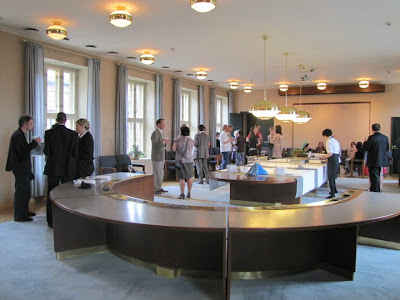

THE ‘HIGH-RISE SHUFFLE’ ALVAR AALTO MEETING TO BE HELD IN JYVÄSKYLÄ ON
SATURDAY 27 AND SUNDAY 28 AUGUST 2011
The International Alvar Aalto Meeting on Modern Architecture being held at the weekend this week will focus on the world of
high-rises: the history of and design solutions for skyscrapers, as well as many different takes on the environmental and social
potential of dense building developments and their effects on their surroundings. Before the meeting, an international
architecture workshop will explore the potential of high-rises to be built in Otaniemi, a district of Espoo.
Antti Ahlava, the chairman of the meeting and the newly appointed head of the Aalto University Department of Architecture,
had this to say about the theme of the meeting:
“It was just announced that Jeddah in Saudi Arabia will get the highest skyscraper in the world, reaching 1 km.
Simultaneously, the city of Espoo is developing its new Finnoo Centre with groups of high-rises. The problems of tall
buildings and the need to create more humanistic versions are more acute than ever.
Our High-Rise Shuffle seminar in Jyväskylä approaches – next weekend! We are anxiously waiting for the great keynote
speeches by some of the leading developers of experimental architecture in the world. Jeanne Gang, the principal of
Studio Gang, is the designer of the groundbreaking Aqua Tower in Chicago. Ulla Hell is a partner in Plasma Studio, the
office responsible for the astonishing International Horticultural Fair in Xian, China. Steffen Lehmann is the idiosyncratic
emphasiser of ethical architecture from Australia. Panu Lehtovuori is one of the leading Finnish urban thinkers. Anne
Stenros is the design director of Kone Corporation, and Zhiqiang Wu is the chief planner of the 2010 Shanghai World
Expo. All of these remarkable guests have been able to combine experimental thinking with groundbreaking architectural
creation.
In addition to the keynote speeches, we will also have state-of-the-art presentations on specific topics related to high-rise
building, infill building, and research and development in architecture. This seminar shows that it is possible to break the
boundary between theory and practice in architecture and that there can be new architecture only with new thinking
behind it.
The seminar will also present an exhibition of new designs in the collaboration between Aalto University and the City of
Espoo, accomplished according to the principles of "Soft Tower" design.”
So we went, Mariola and I, and presented in a Pecha Kucha session a paper tittled:
the void in the city : the graft, the tower, and the (not exactly) new public space
This is a short abstract:
Two ends, at least, meet in one: a kind of aporetical situation. Maybe, in any case, we could conceptualize it through one word, or better saying, by one operation: that of the graft.
Understanding cities as towers, both allows to and demands for a new approach to public space; points to the necessary redefinition of the old pair public/private in those times of globalization—precisely the times when private is overcoming the public. The question is not the “technical” accomplishments of new towers—especially in terms of efficiency, both of space consumption and energy waste—problem solvers of a ecoFriendly and ecoLogical self responsible future (which nevertheless is a main point), but the necessary rethinking of the whole concept of the city in terms of its public/private constitution—included the wired and wireless nets of the virtual “communities” and facebook worshipers.
How could towers in-corporate public space since they are always private (corporate)? That’s the main question if we are going to live them as cities. Because the city, the polis, is defined from its origin in ancient Greece as a political space—and that’s public. Architecture build a void in the city, inoculated what is absolutely different, incommensurable with itself in the form of a negative space, that is neither empty nor static: agora.
Grafting could pave a new approach: grafting and its double logic, between inscription and prescription. What kind of grafting must be exercised upon a tower to develop in its core something akin to an (im)possible agora that will renovate/innovate the political space? A new—but so old—fruit?
The final paper is published in a book, available from Aalto Academ: HighRise Shuffle 2011
María de la O del Santo Mora / José Vela Castillo




